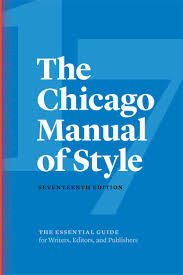This part contains data on The Chicago Manual of Style technique for archive organizing and reference. These assets follow the seventeenth release of The Chicago Manual of Style, which was given in 2017.
Patrons: Jessica Clements, Elizabeth Angeli, Karen Schiller, S. C. Gooch, Laurie Pinkert, Allen Brizee, Ryan Murphy, Vanessa Iacocca, Ryan Schnurr
Last Edited: 2018-01-31 02:26:18
If it's not too much trouble, note that while these assets mirror the latest updates in the seventeenth release of The Chicago Manual of Style concerning documentation rehearses, you can audit a full rundown of updates concerning utilization, innovation, proficient practice, and so forth at The Chicago Manual of Style Online.
To see a next to each other examination of the three most generally utilized reference styles, including a graph of all CMOS reference rules, see the Citation Style Chart.
Presentation
The Chicago Manual of Style (CMOS) covers an assortment of points from original copy planning and distribution to syntax, utilization, and documentation and has been affectionately called the "editors' book of scriptures." The material in this asset centers principally around one of the two CMOS documentation styles: the Notes-Bibliography System (NB), which is utilized by those in writing, history, and human expression. The other documentation style, the Author-Date System, is almost indistinguishable in satisfied yet somewhat disparate in structure and is liked in the sociologies.
As well as counseling The Chicago Manual of Style (seventeenth ed.) for more data, understudies may likewise find it valuable to counsel Kate L. Turabian's Manual for Writers of Research Papers, Theses, and Dissertations (eighth ed.). This manual, which presents what is generally known as the "Turabian" reference style, follows the two CMOS examples of documentation however offers slight alterations fit to understudy messages.
Notes and Bibliography (NB) in Chicago style
The Chicago NB framework is much of the time utilized in the humanities and furnishes essayists with a framework for referring to their sources through commentary or endnote reference in their composition and through book index pages. It likewise offers journalists a source for remarking on those refered to sources. The NB framework is most usually utilized in the discipline of history.
The legitimate utilization of the NB framework can shield essayists from allegations of literary theft, which is the purposeful or unplanned uncredited utilization of source material made by others. In particular, appropriately utilizing the NB framework assembles validity by showing responsibility to source material.
In the event that you are approached to utilize the Chicago NB design, make certain to counsel The Chicago Manual of Style (seventeenth ed.). Understudies ought to likewise allude to A Manual for Writers of Research Papers, Theses, and Dissertations (eighth ed.). Both are accessible in most composing habitats and reference libraries and in book shops
Prologue to Notes
In the NB framework, you ought to incorporate a note (endnote or reference) each time you utilize a source, whether through an immediate statement or through an interpretation or synopsis. Commentaries will be added toward the finish of the page on which the source is referred to, and endnotes will be accumulated toward the finish of every section or toward the finish of the whole archive.
Regardless, a superscript number relating to a note with the bibliographic data for that source ought to be set in the message following the finish of the sentence or proviso in which the source is referred to.
On the off chance that a work incorporates a catalog, it isn't important to give full distribution subtleties in notes. Be that as it may, in the event that a reference index is excluded with a work, the principal note for each source ought to incorporate all significant data about the source: creator's complete name, source title, and realities of distribution. On the off chance that you refer to a similar source once more, or on the other hand assuming a catalog is remembered for the work, the note need just incorporate the last name of the creator, an abbreviated type of the title (if multiple words), and page number(s). In any case, in a work that does exclude a reference index, it is suggested that the full reference be rehashed when it is first utilized in another part..
Rather than prior versions of CMOS, assuming you refer to similar source at least twice continuously, CMOS suggests utilizing abbreviated references. In a work with a book index, the main reference ought to utilize an abbreviated reference which incorporates the writer's name, the source title, and the page number(s), and back to back references to a similar work might discard the source title and just incorporate the writer and page number. Albeit deterred by CMOS, in the event that you refer to a similar source and page number(s) from a solitary source at least twice successively, using "On the same page.," a contracted type of the Latin in the same place, and that signifies "in a similar spot," as the relating note is likewise conceivable. Assuming you utilize a similar source yet an alternate page number, the relating note ought to utilize "In the same place." trailed by a comma and the new page number(s).
In the NB framework, the reference or endnote itself starts with the proper regular number, trailed by a period and afterward a space.
Prologue to Bibliographies
In the NB framework, the book reference gives an in order rundown of all sources utilized in a given work. This page, most frequently named Bibliography, is normally positioned toward the finish of the work going before the file. It ought to incorporate all sources refered to inside the work and may some of the time incorporate other pertinent sources that were not refered to however give further perusing.
Albeit bibliographic passages for different sources might be organized in an unexpected way, all included sources (books, articles, Web destinations, and so on) are organized sequentially by writer's last name. Assuming that no creator or supervisor is recorded, the title or, if all else fails, an unmistakable expression might be utilized.
However helpful, a list of sources isn't needed in works that give full bibliographic data in the notes.
Normal Elements
All passages in the reference index will incorporate the creator (or manager, compiler, interpreter), title, and distribution data.
Creator's Names
The creator's name is modified in the book reference, putting the last name first and isolating the last name and first name with a comma; for instance, John Smith becomes Smith, John. (In the event that a creator isn't recorded first, this applies to compilers, interpreters, and so on.)
Titles
Titles of books and diaries are stressed. Titles of articles, parts, sonnets, and so forth are set in quotes.
Distribution Information
The extended time of distribution is recorded after the distributer or diary name.
Accentuation
In a book index, all significant components are isolated by periods.
For more data and explicit models, see the areas on Books and Periodicals.
Kindly note that this OWL asset gives essential data with respect to the designing of sections utilized in the reference index. For more data about Selected Bibliographies, Annotated Bibliographies, and Bibliographic Essays, if it's not too much trouble, counsel Chapter 14.61 of The Chicago Manual of Style (seventeenth ed.)
 English
English Persian
Persian

